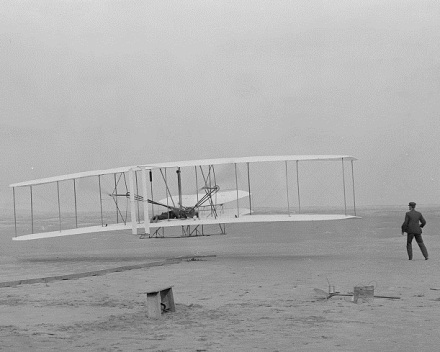December 17 is a big day for aviation history. In 1903, Ohio bicycle makers Orville and Wilbur Wright took their homemade craft down to Kill Devil Hills in North Carolina and became the first to achieve manned, controlled heavier-than-air flight.
The Wrights’ story is well-known thanks to their inclusion in history textbooks, but their success was not preordained. It’s easy to think of their achievement as an isolated and peculiar step forward in a whimsical and quaint era, but manned flight was the tech frontier of the day. Much like today’s internet startups are jockeying to harness the revenue power of social networking, dozens of innovators around the world were racing to harness the power of airflow over a flat surface.
The Wrights had rivals in France and in South America. But their most visible threat was from Samuel Langley, director of the Smithsonian. Langley had successfully flown scale models of his “Aerodrome” craft several years before the Wrights’ triumph. But despite thousands of dollars in government funding, Langley’s design was not robust enough to handle the strains of full-scale, manned flight. It crashed twice in 1903, the second time little more than a week before the Wrights made history with their meticulously tested craft.
The Wrights ushered in a new era in transportation—a massively profitable one for those with the knowhow. The Wrights were issued a patent for their flying machine in 1906, and shortly thereafter, they sued another early aviation titan, Glenn Curtiss, for copying their flight controls and wing designs (think of it as a historical predecessor to the Apple/Samsung patent battle currently raging). The fight lasted until 1918, and even involved an unsuccessful attempt to discredit the Wrights by showing that Langley’s contraption could have worked. That endeavor had the backing of Henry Ford and Langley’s successor at the Smithsonian.
You can now see the Wright Flyer at the Smithsonian’s National Air and Space Museum, but it took decades before Orville Wright would hand over his monumental machine to an organization that had supported his rivals.
Not coincidentally, December 17 marks another aviation milestone: On that day in 1935, the Douglas DC-3 first flew. The airplane is perhaps not as famous as World War II fighters like the P-51 Mustang or stealth jets like the B-2 bomber, but its importance and longevity are essentially unmatched.
The DC-3 was the first commercial airliner that was cost-effective enough to allow struggling airlines to operate without federal Air Mail subsidies. It set a standard for commercial aviation in the 1930s before its reputation for reliability and toughness was earned in battle.
When World War II broke out, the DC-3 was built for the military as a cargo plane and troop hauler. It served in every Allied military, and was even copied by the Japanese. It was the primary airplane that dropped paratroopers behind enemy lines in the hours preceding the D-Day landings in 1944. It flew cargo over mountain ranges to isolated Allied bases in Asia. Dwight Eisenhower wrote that it was one of the six pieces of equipment most important to the Allied victories in Europe and Africa.
The DC-3 continued to serve the U.S. military through the Korean War and even Vietnam. In civilian life, countless surplus DC-3s became airliners in developing areas like South America, where short, unpaved airfields were the norm. Unsurprisingly, the plane’s toughness and availability also made it a favorite of drug smugglers. Nearly seven decades after the last DC-3 rolled off the assembly line, several hundred continue to fly today, some still in commercial service.
Interested in other tales of aviation innovation and daring? Check out this book about the challenges and triumphs of designing the Boeing 747, written by the project’s chief engineer. Read about the larger-than-life personalities competing to be the first to fly nonstop across the Atlantic in 1927. Read about Amelia Earhart’s combination of bravery and media savvy. Or read Tom Wolfe’s classic The Right Stuff, about test pilots, astronauts and the space race.




